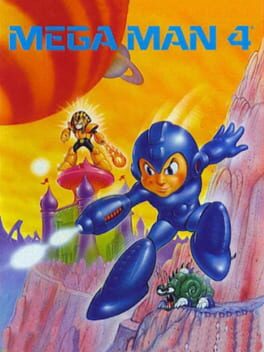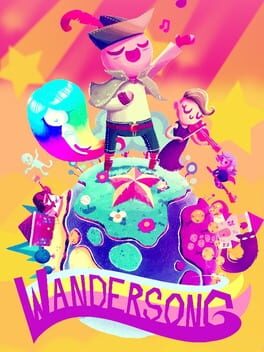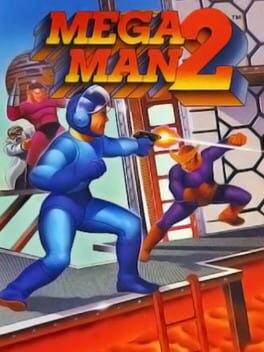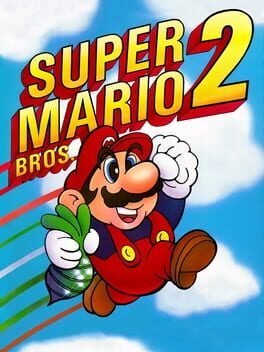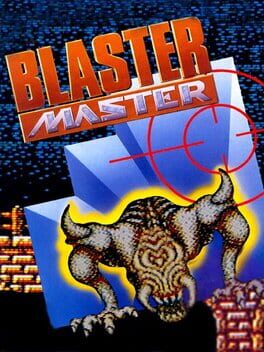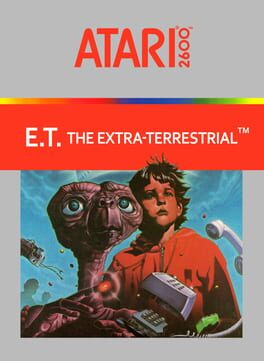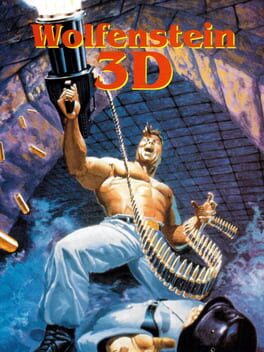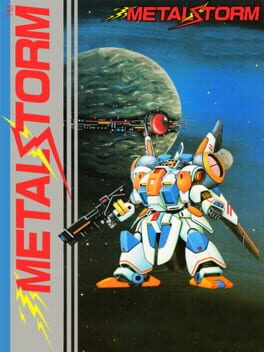tasukete
1477 Reviews liked by tasukete
Mega Man 4
1991
One of the most important games of the franchise, adding the charged buster and a new villain for the first time, an idea the next 2 games would folllow. This game also has the best weapon roster and some of the coolest robot masters. I think it's worse than 3, mainly because of its level design and OST (which is still pretty good), but still a high point in the Mega Man saga.
Super Castlevania IV
1991
It makes me so mad that they kept the mechanic from the NES games where you can’t drop back down in a level. Once you climb up somewhere, if something knocks you off a ledge— which happens OFTEN— you are dead, even if you KNOW there is ground RIGHT THERE, because you were literally just on it. It’s just slightly offscreen! ahhhhh. Enraging.
In general, the platforming in Super Castlevania IV is brittle and terrible-feeling—spikes with giant hitboxes will one-hit-kill you, you have to make these awkward jumps onto the itty bitty corners of ledges all the time, your jumps are often interrupted by some obstacle above you and you die, etc etc. All of that might be acceptable in an NES game, but in the 16-bit generation, it feels like a pretty massive failure to evolve.
However—whippin stuff is fun. The free-swingin chain is especially neat. Though, it sometimes feels as though the game was designed NOT with an all-directional whip in mind, and like that was only implemented late in development… because there are so many enemies you can just whip to death from below super easily, and it feels a bit odd/broken.
Not that the game isn’t difficult. It is. It made me very mad, a lot. Luckily it’s nice enough to give checkpoints and infinite continues and passwords, so I did end up making it to the end— though, I didn’t beat Dracula.
My big problem with Super Castlevania IV, other than the oft-critiqued platforming, is that, for my money, the Castlevania series is all about bops, tunes, jams—and this doesn’t have any. The music is shockingly ineffectual, considering how outright delightful and immediately grabbing the NES soundtracks were.
Overall, I guess it was fun enough… but it just didn’t quite learn the right lessons from the older games. It feels stuck right alongside them, to me, instead of being the entry that pushed the series into the future, as it perhaps wanted to be, and should’ve been.
In general, the platforming in Super Castlevania IV is brittle and terrible-feeling—spikes with giant hitboxes will one-hit-kill you, you have to make these awkward jumps onto the itty bitty corners of ledges all the time, your jumps are often interrupted by some obstacle above you and you die, etc etc. All of that might be acceptable in an NES game, but in the 16-bit generation, it feels like a pretty massive failure to evolve.
However—whippin stuff is fun. The free-swingin chain is especially neat. Though, it sometimes feels as though the game was designed NOT with an all-directional whip in mind, and like that was only implemented late in development… because there are so many enemies you can just whip to death from below super easily, and it feels a bit odd/broken.
Not that the game isn’t difficult. It is. It made me very mad, a lot. Luckily it’s nice enough to give checkpoints and infinite continues and passwords, so I did end up making it to the end— though, I didn’t beat Dracula.
My big problem with Super Castlevania IV, other than the oft-critiqued platforming, is that, for my money, the Castlevania series is all about bops, tunes, jams—and this doesn’t have any. The music is shockingly ineffectual, considering how outright delightful and immediately grabbing the NES soundtracks were.
Overall, I guess it was fun enough… but it just didn’t quite learn the right lessons from the older games. It feels stuck right alongside them, to me, instead of being the entry that pushed the series into the future, as it perhaps wanted to be, and should’ve been.
Sonic the Hedgehog
1991
Very important from a historical perspective, but not that fun from a modern perspective. Its good at Green Hill and then Marble Zone comes in and ruins all your fun. The next few levels are the game trying to collect all the shattered pieces of your fun and gluing them back together.
I'd say play it for historical reasons at the very least but don't force yourself to beat it if you aren't having fun.
I'd say play it for historical reasons at the very least but don't force yourself to beat it if you aren't having fun.
Sonic the Hedgehog
1991
Took me years to finally muster the willpower to sit down and beat Sonic 1 legit... and it sucked ass.
I can absolutely see how this blew the minds of 90s kids with its graphics and sound. There's a level of polish that just blew the stuff you'd see on the NES out of the water, and even cool levels of detail like the reflective sheen on those glass pillars in Marble Zone. And that soundtrack? Green Hill is one of the greatest, most iconic pieces in all of gaming. Not to mention all the other bangers like Marble, Spring Yard, and Scrap Brain. And Sonic, despite saying nothing the whole game, conveyed a lot more personality than pre-64 Mario ever did.
But man, this plays like aaaaaaaaaaaaaass. The momentum is all fucked, the hit detection is spotty, there are blatant moments of bullshit and horrible level design that cheats you out of lives, the checkpoints are poorly spaced, the bonus levels are wonky, and to top it all off, those poor Genesis kids had to play this with NO Spin Dash and NO Drop Dash. The only reason this game should be remembered is for historical purposes, otherwise it's just a bad game.
The highlight of my playthrough was when I got to Spring Yard Zone and the word "COPE" was spelled out in giant neon lighting while getting helplessly tossed around by springs and impossible obstacles. Apt summary of the Sonic 1 experience.
I can absolutely see how this blew the minds of 90s kids with its graphics and sound. There's a level of polish that just blew the stuff you'd see on the NES out of the water, and even cool levels of detail like the reflective sheen on those glass pillars in Marble Zone. And that soundtrack? Green Hill is one of the greatest, most iconic pieces in all of gaming. Not to mention all the other bangers like Marble, Spring Yard, and Scrap Brain. And Sonic, despite saying nothing the whole game, conveyed a lot more personality than pre-64 Mario ever did.
But man, this plays like aaaaaaaaaaaaaass. The momentum is all fucked, the hit detection is spotty, there are blatant moments of bullshit and horrible level design that cheats you out of lives, the checkpoints are poorly spaced, the bonus levels are wonky, and to top it all off, those poor Genesis kids had to play this with NO Spin Dash and NO Drop Dash. The only reason this game should be remembered is for historical purposes, otherwise it's just a bad game.
The highlight of my playthrough was when I got to Spring Yard Zone and the word "COPE" was spelled out in giant neon lighting while getting helplessly tossed around by springs and impossible obstacles. Apt summary of the Sonic 1 experience.
Wandersong
2018
While Wandersong begins with pitch-perfect puzzles and story beats, its writing quickly becomes quite one-note, and the dragging coda will likely dissuade players from enjoying repeat performances.
Wandersong is the story of a young bard whose mission, in the face of a looming apocalypse, is to gather the pieces of the mythical Eversong, the united musical intonations of all the living, to repel disaster. The bard is joined by Miriam, a cynical but talented witch, and they visit a great many locales filled with unique denizens to seek out the keepers of the pieces of the Eversong, the Overseers.
Early on, it is established that the bard is not the hero of this tale—that would be The Hero, who wields a sword that shoots lightning and wishes to kill the Overseers to accelerate the end of the world and the creation of the next. The bard and Miriam pursue their mission peacefully, with the bard’s musical stylings the key to their success (reflecting the game itself, which with a couple notable exceptions, excels most in its choonz), whether it’s in convincing townspeople or animals to help them or by generating magical spells.
Thus, the game has a very simple subversion as the core of its gameplay and narrative. While the concept of the traditional video game hero as a raging murderous psychopath and the player’s insertion into an unbecoming, non-traditional hero isn’t new, the game uses it well enough for the opening hours. The bard and Miriam are likeable enough characters and play off each other well. You really get to share the bard’s stupid optimism and distrust of The Hero. And then it’s fun to suddenly find yourself playing as The Hero for a brief section, playing a serviceable action platformer.
As the bard, you will constantly be met with pastiche of different genres. While you’re basically always playing a puzzle platformer, some towns will have light life sim elements with day/night cycles or require small fetch quests or play more like a narrative-focused “walking sim” like Night in the Woods. The dungeons, if you can call them that, always have a new singing-controlled gimmick. Boss fights and Act-ending puzzles (used to actually learn the Earthsong) are varied enough to stay fresh, and when they work, they work well. The gameplay never gets particularly interesting, but the novelty is entertaining enough for a while.
What’s really going to make or break the game for you is if you enjoy its writing. While, like all things in Wandersong, it starts off delightful, a nagging sensation begins to form as you get deeper into the story. The problem for me is this: every single character speaks in exactly the same voice. For a game like Wandersong, where a large part of the appeal is in charming dialogue and character writing, it’s a huge issue when everyone sounds like a standard online millennial. Every single character has the same obnoxious, vaguely sarcastic way of interacting with one another. When it comes time for a character’s arc to develop, no matter what the character’s troubles or ostensible personality traits, they become unbelievably emotionally intelligent and open. I can certainly understand and appreciate that the bard is a wonderful, charming force for good in the world, but these kinds of characters typically need foils, and even the gruffest and rudest denizens of one of the half dozen or so locales the player visits talks in the same, y’know, um… voice. I certainly would never ask a game with the charm and optimistic aim of Wandersong to create emotionally ambiguous resolutions for its characters, but having the characters be characters instead of vehicles for snappy dialogue and repetitive themes about accepting themselves would be greatly appreciated. While the character designs are lovely, and I admire the ambition of creating a great ensemble cast the player would become invested in for the grand resolution, simplifying the game to include fewer characters might have helped to add to the variety of proceedings and allowed some time for characters and their arcs to breathe. By the end of the game, I found myself completely disinterested in hearing the same fucking tone of voice from another town full of people and trying to keep it down when it was force-fed to me during required story interactions contained to the main few characters.
The gameplay similarly sees the wheels fly off by the end of the game. The challenge never develops at all, and instead puzzles just cycle through new gimmicks. This is perfectly fine, but just as a mechanic seems to feel like it’s working and producing some interesting gameplay, the game cuts it off. So you’re constantly teased with fun scenarios with new abilities, just to have them ripped away for an exhausting stretch of dialogue before you move on to the next puzzle gimmick that will be completely under-utilized for a good 75% of the time you’re using it. The ending stretch doesn’t even feature fun gimmicks to begin with and often feel like tedious, simplistic slogs. It’s in these moments, where you’re sitting there doing something stupidly simple, that the little quirks start to feel extremely irritating.
My performance in the game is not really impacted by my ability to keep up with a piece of music or gameplay (the worst penalty is moving back about twenty seconds in a boss encounter at absolute worst), but I’d like to hear this song properly or react to this boss quickly (mostly so I can get one of Wandersong’s horrible boss battles over with faster). Why, oh why, does Wandersong’s metronome feature for pointing out which direction to mash your right analog stick not function like any other rhythm game ever? And why did they put dead zones between the eight input directions of the controller when your stick is resting at center? I’m not playing this on the GameCube. I’m not gonna be able to switch from one side to another (through dead center, always, for boss battles) with pinpoint accuracy if you make the dead zones show up when they’re most cumbersome!
Honestly, if Wandersong were a bit tighter, trimming off some of the more redundant areas to make a solid, say, four-act story with varied and interesting characters, these gripes about the mechanics and dialogue would probably be much more minor. But subjecting myself to seven hours of this felt like complete misery by the end. And for those of you who have finished the game, I’ll just let you imagine how red my face was as I played through that endless, tuneless epilogue cutscene… twice…
Wandersong is the story of a young bard whose mission, in the face of a looming apocalypse, is to gather the pieces of the mythical Eversong, the united musical intonations of all the living, to repel disaster. The bard is joined by Miriam, a cynical but talented witch, and they visit a great many locales filled with unique denizens to seek out the keepers of the pieces of the Eversong, the Overseers.
Early on, it is established that the bard is not the hero of this tale—that would be The Hero, who wields a sword that shoots lightning and wishes to kill the Overseers to accelerate the end of the world and the creation of the next. The bard and Miriam pursue their mission peacefully, with the bard’s musical stylings the key to their success (reflecting the game itself, which with a couple notable exceptions, excels most in its choonz), whether it’s in convincing townspeople or animals to help them or by generating magical spells.
Thus, the game has a very simple subversion as the core of its gameplay and narrative. While the concept of the traditional video game hero as a raging murderous psychopath and the player’s insertion into an unbecoming, non-traditional hero isn’t new, the game uses it well enough for the opening hours. The bard and Miriam are likeable enough characters and play off each other well. You really get to share the bard’s stupid optimism and distrust of The Hero. And then it’s fun to suddenly find yourself playing as The Hero for a brief section, playing a serviceable action platformer.
As the bard, you will constantly be met with pastiche of different genres. While you’re basically always playing a puzzle platformer, some towns will have light life sim elements with day/night cycles or require small fetch quests or play more like a narrative-focused “walking sim” like Night in the Woods. The dungeons, if you can call them that, always have a new singing-controlled gimmick. Boss fights and Act-ending puzzles (used to actually learn the Earthsong) are varied enough to stay fresh, and when they work, they work well. The gameplay never gets particularly interesting, but the novelty is entertaining enough for a while.
What’s really going to make or break the game for you is if you enjoy its writing. While, like all things in Wandersong, it starts off delightful, a nagging sensation begins to form as you get deeper into the story. The problem for me is this: every single character speaks in exactly the same voice. For a game like Wandersong, where a large part of the appeal is in charming dialogue and character writing, it’s a huge issue when everyone sounds like a standard online millennial. Every single character has the same obnoxious, vaguely sarcastic way of interacting with one another. When it comes time for a character’s arc to develop, no matter what the character’s troubles or ostensible personality traits, they become unbelievably emotionally intelligent and open. I can certainly understand and appreciate that the bard is a wonderful, charming force for good in the world, but these kinds of characters typically need foils, and even the gruffest and rudest denizens of one of the half dozen or so locales the player visits talks in the same, y’know, um… voice. I certainly would never ask a game with the charm and optimistic aim of Wandersong to create emotionally ambiguous resolutions for its characters, but having the characters be characters instead of vehicles for snappy dialogue and repetitive themes about accepting themselves would be greatly appreciated. While the character designs are lovely, and I admire the ambition of creating a great ensemble cast the player would become invested in for the grand resolution, simplifying the game to include fewer characters might have helped to add to the variety of proceedings and allowed some time for characters and their arcs to breathe. By the end of the game, I found myself completely disinterested in hearing the same fucking tone of voice from another town full of people and trying to keep it down when it was force-fed to me during required story interactions contained to the main few characters.
The gameplay similarly sees the wheels fly off by the end of the game. The challenge never develops at all, and instead puzzles just cycle through new gimmicks. This is perfectly fine, but just as a mechanic seems to feel like it’s working and producing some interesting gameplay, the game cuts it off. So you’re constantly teased with fun scenarios with new abilities, just to have them ripped away for an exhausting stretch of dialogue before you move on to the next puzzle gimmick that will be completely under-utilized for a good 75% of the time you’re using it. The ending stretch doesn’t even feature fun gimmicks to begin with and often feel like tedious, simplistic slogs. It’s in these moments, where you’re sitting there doing something stupidly simple, that the little quirks start to feel extremely irritating.
My performance in the game is not really impacted by my ability to keep up with a piece of music or gameplay (the worst penalty is moving back about twenty seconds in a boss encounter at absolute worst), but I’d like to hear this song properly or react to this boss quickly (mostly so I can get one of Wandersong’s horrible boss battles over with faster). Why, oh why, does Wandersong’s metronome feature for pointing out which direction to mash your right analog stick not function like any other rhythm game ever? And why did they put dead zones between the eight input directions of the controller when your stick is resting at center? I’m not playing this on the GameCube. I’m not gonna be able to switch from one side to another (through dead center, always, for boss battles) with pinpoint accuracy if you make the dead zones show up when they’re most cumbersome!
Honestly, if Wandersong were a bit tighter, trimming off some of the more redundant areas to make a solid, say, four-act story with varied and interesting characters, these gripes about the mechanics and dialogue would probably be much more minor. But subjecting myself to seven hours of this felt like complete misery by the end. And for those of you who have finished the game, I’ll just let you imagine how red my face was as I played through that endless, tuneless epilogue cutscene… twice…
Wandersong
2018
Bounced off this pretty hard, abandoning it as Act 4 was about to begin. The biggest problem is the rpg sections take up a huge portion of the game-time despite being largely insipid. I'm given no reason to care about this quest beyond saving the world being a generically good thing to do, and no reason to care about these characters who are at best shallow and one-note (he's the happy one, she's the grumpy one, etc) and at worst have a habit of all blending together and sounding the same. I spent the majority of the rpg sections just bored.
The platforming and puzzle-solving sections are largely fine but rarely achieve much more than that, with the mechanics I saw varying from decent but underdeveloped, to pretty awkward. That said, I strongly disliked the song portions, which depending on which approach the game takes either lack a sense of rhythm or lack a sense of my actions actually mattering at all. Also encountered few small bugs, and the controls for the singing did not feel very smooth requiring you to be very specific with you control-stick movements.
Honestly talking myself down on this the more and more I type.
The platforming and puzzle-solving sections are largely fine but rarely achieve much more than that, with the mechanics I saw varying from decent but underdeveloped, to pretty awkward. That said, I strongly disliked the song portions, which depending on which approach the game takes either lack a sense of rhythm or lack a sense of my actions actually mattering at all. Also encountered few small bugs, and the controls for the singing did not feel very smooth requiring you to be very specific with you control-stick movements.
Honestly talking myself down on this the more and more I type.
Mega Man 2
1989
A breakthrough for gaming, unforgettable if you played it in the 80s, and loads of fun even today. There are a bunch of detailed reviews already, so here are some odd similarities with Dark Souls:
1. It's notorious for being tough, but compared to other games its difficulty is only moderately high (this isn't a flex, they're both very difficult for me! But there are much tougher games out there).
2. Much of the difficulty is easily overcome with knowledge plus simple strategies. An example (aside from boss weaknesses) is a tricky platforming section in Heat Man's stage can be skipped with item 2 (I'm convinced every kid did this in 1989 and felt like a genius). It's an obvious strat once you know item 2 exists, but if it's your first playthrough you probably won't. Similarly, knowledge of the rusted iron ring in Dark Souls eases the pain in Blighttown and Sen's fortress, but it's easily miss-able.
3. Metal blade = magic build.
4. Several late-game segments seem rushed and unfinished (Wily 4, Tomb of Giants).
5. There's even a cheap puzzle boss in each game (Boobeam trap, Bed of Chaos). Granted, Bed of Chaos is more frustrating, but arriving at the Boobeam trap without full Crash Bombs only to discover I'm doomed would certainly make me sling a few fuck-words.
6. The final boss is kind of a pushover.
7. Both games launched their series' to legendary status.
1. It's notorious for being tough, but compared to other games its difficulty is only moderately high (this isn't a flex, they're both very difficult for me! But there are much tougher games out there).
2. Much of the difficulty is easily overcome with knowledge plus simple strategies. An example (aside from boss weaknesses) is a tricky platforming section in Heat Man's stage can be skipped with item 2 (I'm convinced every kid did this in 1989 and felt like a genius). It's an obvious strat once you know item 2 exists, but if it's your first playthrough you probably won't. Similarly, knowledge of the rusted iron ring in Dark Souls eases the pain in Blighttown and Sen's fortress, but it's easily miss-able.
3. Metal blade = magic build.
4. Several late-game segments seem rushed and unfinished (Wily 4, Tomb of Giants).
5. There's even a cheap puzzle boss in each game (Boobeam trap, Bed of Chaos). Granted, Bed of Chaos is more frustrating, but arriving at the Boobeam trap without full Crash Bombs only to discover I'm doomed would certainly make me sling a few fuck-words.
6. The final boss is kind of a pushover.
7. Both games launched their series' to legendary status.
Super Mario Bros. 2
1988
This could be more of a Doki Doki Panic review, but at this rate that game is more famous as Mario 2 than it is DDP. It may not be a sequel to the first, but I argue it actually serves its job better than the actual sequel (which is complete s#!t, by the way.) Either way, it's a fun romp from beginning to end.
The levels are much longer than the first, though there are less of them. The bosses are the best of any Mario game on NES, The graphics are leagues above it, and while I am disappointed they got rid of multiplayer and power-ups, I'm willing to accept it for different characters. Peach is my favorite, followed by Luigi, Mario, then Toad. The powerups here are great too. Chucking turnips or yeeting enemies into each other feels surprisingly good. Doors, extra health mechanics, more clever warp zones, and much better enemies. It's a bit harder than the first too, which has grown to be pretty easy to me. A nice balance between extreme ease and difficulty.
Overall, I find this game to be very, very fun. It's a happy, upbeat journey from start to end. Super Mario Bros 2: Mario Madness deserves being called the successor to the original.
The levels are much longer than the first, though there are less of them. The bosses are the best of any Mario game on NES, The graphics are leagues above it, and while I am disappointed they got rid of multiplayer and power-ups, I'm willing to accept it for different characters. Peach is my favorite, followed by Luigi, Mario, then Toad. The powerups here are great too. Chucking turnips or yeeting enemies into each other feels surprisingly good. Doors, extra health mechanics, more clever warp zones, and much better enemies. It's a bit harder than the first too, which has grown to be pretty easy to me. A nice balance between extreme ease and difficulty.
Overall, I find this game to be very, very fun. It's a happy, upbeat journey from start to end. Super Mario Bros 2: Mario Madness deserves being called the successor to the original.
Blaster Master
1988
I'm stuck on Area 3
It's like Metroid. Amazing music, nice atmosphere for NES standards, it's a technical marvel...
But the exploration platformer genre was simply not there yet in terms of its game design mentality branching out from the action platformer in the right ways, and in terms of its now laser-focused awareness on what quality of life features the genre needs, or at least benefits heavily from.
I want to play Blaster Master Zero one day, though. It looks like good fun!
It's like Metroid. Amazing music, nice atmosphere for NES standards, it's a technical marvel...
But the exploration platformer genre was simply not there yet in terms of its game design mentality branching out from the action platformer in the right ways, and in terms of its now laser-focused awareness on what quality of life features the genre needs, or at least benefits heavily from.
I want to play Blaster Master Zero one day, though. It looks like good fun!
Attempted a noncommital playthrough since this game has a rancid reputation for a reason. Needless to say, I gave up pretty early on and I was more than okay dropping it on a dime. Castlevania II has some neat features like its graphical style and bangin' soundtrack, but besides that, I can't say this is a pleasant gaming experience even with save states.
Super Mario Bros.
1985
It struck me while playing through a bunch of other old platformers that the way Mario runs with the B button and gradually accelerates was seldom replicated. Most games used the B button for a weapon of some sort, and the player character moved at one consistent speed. It was probably hard to program the way that speed could change the distance of jumps and such, but a game did eventually focus on copying this aspect of Mario with Sonic the Hedgehog, making the acceleration innate rather than requiring the player to hold down a button. Sonic happened to become Mario's biggest competitor. Maybe Go Fast is a more universally appealing idea than Kill Stuff.
Ghosts 'n Goblins
1985
(I'd screwed around with this when I was a lot younger and obviously didn't get very far, so I decided to try playing with savestates just to see a bit more of the game.)
One very common post on the whowouldwin reddit is some variant of "regular guy with infinite savestates vs prime Mike Tyson" or "MMA fighter with infinite savestates vs silverback gorilla". I used to think that surely with infinite savestates all you would have to do is keep reloading until you get a lucky shot or your opponent injured themselves by a fluke, but now I know that faced with odds that long, you're more likely to eventually give up and let yourself die.
Thus ends my journey with Ghosts n Goblins; the game looks good for its time, the designs have lots of personality, and the idea of spending most of your playtime running around in your boxers is a funny touch. But it's so difficult, and not in a well-designed way, that even though I'm a compulsive completer of games, I think in this case I'm okay with just letting the silverback gorilla win.
One very common post on the whowouldwin reddit is some variant of "regular guy with infinite savestates vs prime Mike Tyson" or "MMA fighter with infinite savestates vs silverback gorilla". I used to think that surely with infinite savestates all you would have to do is keep reloading until you get a lucky shot or your opponent injured themselves by a fluke, but now I know that faced with odds that long, you're more likely to eventually give up and let yourself die.
Thus ends my journey with Ghosts n Goblins; the game looks good for its time, the designs have lots of personality, and the idea of spending most of your playtime running around in your boxers is a funny touch. But it's so difficult, and not in a well-designed way, that even though I'm a compulsive completer of games, I think in this case I'm okay with just letting the silverback gorilla win.
I know that there are plenty of things to say and not say about ET and how utterly horrible of a game it is. but honestly I'd rather talk about the things surrounding the game, such as the urban legend turned true about how this game, among other infamous Atari 2600 games, were buried in a New Mexico landfill as they couldn't move units in stores. or how this game was rushed out in SIX WEEKS to hit store shelves. even the most rushed of modern games had more time put into them than six weeks
this game wasn't the prime reason for the video game crash of 1983 - it just makes for an incredibly easy and very visible scapegoat. I think this is a game every self-professed gamer should play at least once, even if it's absolutely horrible. it's important to get a little perspective into finding out why the video game ecosystem is the way it is, and especially why early Nintendo was the way it was. and, yknow, how capitalism ends up requiring the mass manufacturing of bad art in order to prop up entire industries for the sake of profit, no matter how much the customer hates it in the end, or something. it's 2:30 AM where I live
this game wasn't the prime reason for the video game crash of 1983 - it just makes for an incredibly easy and very visible scapegoat. I think this is a game every self-professed gamer should play at least once, even if it's absolutely horrible. it's important to get a little perspective into finding out why the video game ecosystem is the way it is, and especially why early Nintendo was the way it was. and, yknow, how capitalism ends up requiring the mass manufacturing of bad art in order to prop up entire industries for the sake of profit, no matter how much the customer hates it in the end, or something. it's 2:30 AM where I live
Wolfenstein 3D
1992
I do have a few fond pieces of nostalgia for Wolfenstein 3D and it did pretty much help pave the way for Doom but unlike Doom, Wolfenstein 3D hasnt aged quite as well.
Part of this is down to the hit-scan enemies who can sometimes detect you from across the map if you happen to be unlucky. Said enemies also usually hit like a truck which is a double-whammy of unfortunate. The other main issue is the game's lack of variety in its tilesets leading to a lot of backtracking, pacing back and forth and key-hunting around countless identical corridors. Its all too easy to be completely flummoxed for half an hour looking for one key hidden across the map.
Is it still fun though? Yeah theres still some fun here but its really only recommended for people who have fond memories of the game, less so for any newcomers.
Part of this is down to the hit-scan enemies who can sometimes detect you from across the map if you happen to be unlucky. Said enemies also usually hit like a truck which is a double-whammy of unfortunate. The other main issue is the game's lack of variety in its tilesets leading to a lot of backtracking, pacing back and forth and key-hunting around countless identical corridors. Its all too easy to be completely flummoxed for half an hour looking for one key hidden across the map.
Is it still fun though? Yeah theres still some fun here but its really only recommended for people who have fond memories of the game, less so for any newcomers.
Metal Storm
1991
Metal Storm is a game I truly love, but I have a hard time talking about it. It’s perfectly polished and looks fantastic, but it’s still just an NES platformer. To anyone without the context of the console’s usual limitations, or the common design pitfalls of its time, it would seem about half as impressive as it really is. The smoothness of the animations is better than even the majority of SNES games, and the difficulty is perfectly tuned to be satisfying but not time-wasting, unlike its “Nintendo Hard” contemporaries. But, if you remove the reference points from that evaluation and only judge it by a modern standard, all you’re left with is “it looks fine, and it isn’t frustrating”. While it may not stand out much compared to the NES throwbacks of today, it doesn’t change how the developers broke past the limitations of their time to create a game that’s still highly enjoyable over thirty years later. The fact that it can be compared at all to the NES throwback games, with their advantages of decades of retrospect and technological improvements, is a marvel in itself. Even if you do end up finding it half as impressive as I do, it will still be well worth your time.
